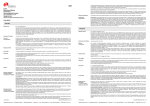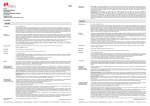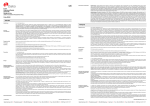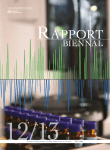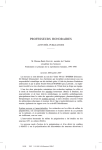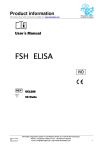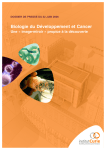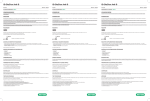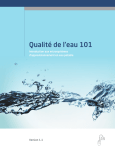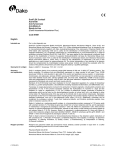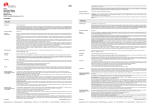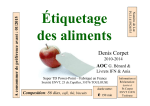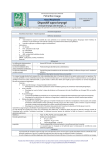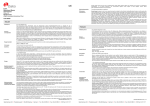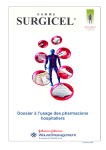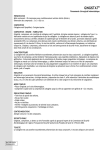Download FLEX Polyclonal Rabbit Anti-Glial Fibrillary Acidic Protein
Transcript
Normal tissues: The antibody labels astrocytes in the brain (3), follicular-stellate cells of the pituitary gland (7), Schwann cells, and enteric glia cells. Additionally, myoepithelial cells of the breast (6) are labeled. In brain, the astrocytes show a moderate to strong staining reaction. In colon, the ganglion cells in the Auerbach and Meissners plexus show weak to moderate staining reaction. No staining is observed in bladder, connective tissue, liver, lymphatic tissue, muscle, pancreas, skin and ureter. Abnormal tissues: All of 23 glioblastoma multiforme (GBM) were labeled by the antibody. In 20 of the 23 GBMs, at least 50% of malignant cells were positive for GFAP. Only 3 of 22 cases of carcinoma metastatic to the brain were labeled. This labeling was focal and limited to less than 10% of malignant cells (3). 5/5 hemispheric astrocytomas of the rare granular type showed focal GFAP positivity with the antibody (4), which also labeled 7/7 pleomorphic xanthoastrocytomas (8), and anterior lobe folliculo-stellate cells in 20/20 pituitary neoplasms (7). In medulloblastoma (MB) of the “desmoplastic variant”, the antibody labeled 8/11 cases. The labeling appeared as focal areas of GFAP-positive cells with neoplastic morphology. Only 4/31 MBs of the “classic variant” showed this type of neoplastic cells, but in classic MB GFAP-positive cells with the morphology of reactive astrocytes were observed in 27/31 cases (9). The antibody has also been shown to label 15/38 schwannomas (38%), and 2 cases of plexiform neurofibroma, while 16 cases of dermal neurofibroma were negative (10). In various neoplastic and non-neoplastic diseases of the breast, the percentage of myoepithelial cells reactive with the antibody was greatly increased as compared to the normal breast, while positivity was not encountered in the malignant cells of 183 breast carcinomas of different types (6). The antibody did not label meningiomas in a study including 36 patients (11). Performance characteristics FLEX Polyclonal Rabbit Anti-Glial Fibrillary Acidic Protein Ready-to-Use (Dako Autostainer/Autostainer Plus) Code IS524 ENGLISH FRANÇAIS For in vitro diagnostic use. FLEX Polyclonal Rabbit Anti-Glial Fibrillary Acidic Protein, Ready-to-Use (Dako Autostainer/Autostainer Plus), is intended for use in immunohistochemistry together with Dako Autostainer/Autostainer Plus instruments. Glial fibrillary acidic protein (GFAP) is the principal intermediate filament of mature astrocytes (1), and this antibody is useful for the identification of astrocytes in the central nervous system (CNS) under normal and pathological conditions (2-4). The clinical interpretation of any staining or its absence should be complemented by morphological studies using proper controls and should be evaluated within the context of the patient's clinical history and other diagnostic tests by a qualified pathologist. Intended use GFAP is a 50 kDa intracytoplasmic filamentous protein that constitutes a portion of the cytoskeleton in astrocytes, and it has proved to be the most specific marker for cells of astrocytic origin. In the central rod domain of the molecule, GFAP shares considerable structural homology with the other intermediate filaments (5). Functionally, GFAP is thought to be important in astrocyte motility and shape by providing structural stability to astrocytic processes (1). Following injury to the human CNS caused by trauma, genetic disorders, or chemicals, astrocytes proliferate and show extensive hypertrophy of the cell body and processes, and GFAP is markedly upregulated. In contrast, with increasing astrocyte malignancy, there is a progressive loss of GFAP production. Thus, malignant astrocytomas have fewer tumour cells that stain positively and intensely for GFAP than do less malignant astrocytomas and normal brain specimens (5). Outside the CNS, sensitive detection methods may demonstrate GFAP in Schwann cells, enteric glia cells, salivary gland neoplasms, and metastasizing renal carcinomas. Additionally, GFAP immunoreactivity has been demonstrated in epiglottic cartilage, pituicytes, immature oligodendrocytes, papillary meningiomas (1), and myoepithelial cells of the breast (6). Refer to Dako’s General Instructions for Immunohistochemical Staining or the detection system instructions of IHC procedures for: 1) Principle of Procedure, 2) Materials Required, Not Supplied, 3) Storage, 4) Specimen Preparation, 5) Staining Procedure, 6) Quality Control, 7) Troubleshooting, 8) Interpretation of Staining, 9) General Limitations. Summary and explanation Utilisation prévu Pour utilisation lors d’un diagnostic in vitro. FLEX Polyclonal Rabbit Anti-Glial Fibrillary Acidic Protein, Ready-to-Use (Dako Autostainer/Autostainer Plus) est destiné à une utilisation en immunohistochimie avec les instruments Dako Autostainer/Autostainer Plus. La protéine acide fibrillaire gliale (GFAP) est le principal filament intermédiaire des astrocytes matures (1) et cet anticorps est utile pour l’identification des astrocytes dans le système nerveux central (SNC) dans des conditions normales et pathologiques (2-4). L’interprétation clinique de toute coloration ou son absence doit être complétée par des études morphologiques en utilisant des contrôles appropriés et doit être évaluée en fonction des antécédents cliniques du patient et d’autres tests diagnostiques par un pathologiste qualifié. Résumé et explication La GFAP est une protéine filamenteuse intracytoplasmique de 50 kDa constituant une partie du cytosquelette des astrocytes. Il a été prouvé que cette protéine est le marqueur le plus spécifique des cellules d’origine astrocytaire. Dans le domaine central en forme de bâtonnet de la molécule, la GFAP partage une homologie de structure considérable avec les autres filaments intermédiaires (5). D’un point de vue fonctionnel, on pense que la GFAP est importante dans la motilité et la forme des astrocytes en fournissant une stabilité structurale aux prolongements astrocytaires (1). À la suite d’une lésion du SNC humain provoquée par un traumatisme, des troubles génétiques ou des produits chimiques, les astrocytes prolifèrent et présentent une hypertrophie extensive du corps cellulaire et des prolongements. De plus, la GFAP fait l’objet d’une régulation positive conséquente. À l’opposé, lors d’une malignité croissante des astrocytes, il y a perte progressive de la production de GFAP. Par conséquent, les astrocytomes malins présentent moins de cellules tumorales colorées positivement et intensément à la GFAP que les astrocytomes moins malins et les échantillons de cerveau sain (5). En dehors du SNC, des méthodes de détection sensibles peuvent montrer la présence de GFAP dans les cellules de Schwann, dans les cellules gliales entériques, dans les néoplasmes des glandes salivaires et dans les carcinomes rénaux métastatiques. De plus, la réactivité immunologique de la GFAP a été démontrée dans le cartilage épiglottique, les pituicytes, les oligodendrocytes immatures, les méningiomes papillaires (1) et les cellules myoépithéliales du sein (6). Se référer aux Instructions générales de coloration immunohistochimique de Dako ou aux instructions du système de détection relatives aux procédures IHC pour plus d’informations concernant les points suivants : 1) Principe de procédure, 2) Matériels requis mais non fournis, 3) Conservation, 4) Préparation des échantillons, 5) Procédure de coloration, 6) Contrôle qualité, 7) Dépannage, 8) Interprétation de la coloration, 9) Limites générales. Reagent provided Ready-to-use polyclonal rabbit antibody provided in liquid form in a buffer containing stabilizing protein and 0.015 mol/L sodium azide. Immunogen GFAP isolated from cow spinal cord. Specificity The antibody has been solid-phase absorbed with human and cow serum proteins. In crossed immunoelectrophoresis using 50 µL concentrated antibody per cm2 gel area, no reaction with 2 µL human plasma and 2 µL cow serum is observed. The antibody shows one distinct precipitate (GFAP) with cow brain extract. Staining: Coomassie Brilliant Blue. In indirect ELISA, the antibody shows no reaction with human plasma and cow serum. Réactifs fournis Anticorps polyclonal de lapin prêt à l’emploi fourni sous forme liquide dans un tampon contenant une protéine stabilisante et 0,015 mol/L d’azide de sodium. Immunogène GFAP isolée à partir de moelle épinière bovine. 1. For professional users. 2. This product contains sodium azide (NaN3), a chemical highly toxic in pure form. At product concentrations, though not classified as hazardous, sodium azide may react with lead and copper plumbing to form highly explosive build-ups of metal azides. Upon disposal, flush with large volumes of water to prevent metal azide build-up in plumbing. 3. As with any product derived from biological sources, proper handling procedures should be used. 4. Wear appropriate Personal Protective Equipment to avoid contact with eyes and skin. 5. Unused solution should be disposed of according to local, State and Federal regulations. Spécificité L’anticorps a été absorbé en phase solide en utilisant des protéines de sérums humain et bovin. Dans l’immunoélectrophorèse croisée avec 50 µL d’anticorps concentré par cm2 de gel, aucune réaction avec 2 µL de plasma humain et 2 µL de sérum bovin n’est observée. L’anticorps révèle un précipité net (GFAP) avec un extrait de cerveau bovin. Coloration : bleu de Coomassie Lors d’un test ELISA indirect, l’anticorps ne présente aucune réaction avec le plasma humain et le sérum bovin. Précautions 1. Pour utilisateurs professionnels. 2. Ce produit contient de l’azide de sodium (NaN3), produit chimique hautement toxique dans sa forme pure. Aux concentrations du produit, bien que non classé comme dangereux, l’azide de sodium peut réagir avec le cuivre et le plomb des canalisations et former des accumulations d’azides métalliques hautement explosifs. Lors de l’élimination, rincer abondamment à l’eau pour éviter toute accumulation d’azide métallique dans les canalisations. 3. Comme avec tout produit d’origine biologique, des procédures de manipulation appropriées doivent être respectées. 4. Porter un vêtement de protection approprié pour éviter le contact avec les yeux et la peau. 5. Les solutions non utilisées doivent être éliminées conformément aux réglementations locales et nationales. Conservation Conserver entre 2 et 8 °C. Ne pas utiliser après la date de péremption indiquée sur le flacon. Si les réactifs sont conservés dans des conditions autres que celles indiquées, celles-ci doivent être validées par l’utilisateur. Il n’y a aucun signe évident indiquant l’instabilité de ce produit. Par conséquent, des contrôles positifs et négatifs doivent être testés en même temps que les échantillons de patient. Si une coloration inattendue est observée, qui ne peut être expliquée par un changement des procédures du laboratoire, et en cas de suspicion d’un problème lié à l’anticorps, contacter l’assistance technique de Dako. Préparation des échantillons y compris le matériel requis mais non fourni L’anticorps peut être utilisé pour le marquage des coupes de tissus inclus en paraffine et fixés au formol. L’épaisseur des coupes d’échantillons de tissu doit être d’environ 4 µm. Un prétraitement avec démasquage d’épitope induit par la chaleur (HIER) est nécessaire avec le Dako PT Link (Réf. PT100/PT101). Pour plus de détails, se référer au Guide d’utilisation du PT Link. Des résultats optimaux sont obtenus en prétraitant les tissus à l’aide de la EnVision FLEX Target Retrieval Solution, High pH (50x) (Réf. K8010/K8004). Coupes incluses en paraffine : le prétraitement des coupes tissulaires fixées au formol et incluses en paraffine est recommandé à l'aide de la procédure de préparation d'échantillon 3-en-un pour le Dako PT Link. Suivre la procédure de prétraitement indiquée dans la notice de la EnVision FLEX Target Retrieval Solution, High pH (50x) (Réf. K8010/K8004). Remarque : après coloration, les coupes doivent être déshydratées, lavées et montées à l’aide d’un milieu de montage permanent. Coupes déparaffinées : le prétraitement des coupes tissulaires déparaffinées, fixées au formol et incluses en paraffine, est recommandé à l’aide du Dako PT Link, en suivant la même procédure que pour les coupes incluses en paraffine. Après coloration, un montage aqueux ou permanent des lames est recommandé. Les coupes de tissus ne doivent pas sécher lors du traitement ni lors de la procédure de coloration immunohistochimique suivante. Pour une meilleure adhérence des coupes de tissus sur les lames de verre, il est recommandé d’utiliser des lames FLEX IHC Microscope Slides (Réf. K8020). Procédure de coloration y compris le matériel requis mais non fourni Le système de visualisation recommandé est le EnVision FLEX, High pH, (Dako Autostainer/Autostainer Plus) (Code K8010). Les étapes de coloration et les temps d’incubation sont préprogrammés dans le logiciel des instruments Dako Autostainer/Autostainer Plus, à l’aide des protocoles suivants : Protocole modèle : FLEXRTU2 (volume d’application de 200 µL) ou FLEXRTU3 (volume d’application de 300 µL). Programme automatique : GFAP (sans contre-coloration) ou GFAPH (avec contre-coloration). Precautions Storage Store at 2-8 °C. Do not use after expiration date sta mped on vial. If reagents are stored under any conditions other than those specified, the conditions must be verified by the user. There are no obvious signs to indicate instability of this product. Therefore, positive and negative controls should be run simultaneously with patient specimens. If unexpected staining is observed which cannot be explained by variations in laboratory procedures and a problem with the antibody is suspected, contact Dako Technical Support. Specimen preparation including materials required but not supplied The antibody can be used for labeling formalin-fixed, paraffin-embedded tissue sections. Tissue specimens should be cut into sections of approximately 4 µm. Pre-treatment with heat-induced epitope retrieval (HIER) is required using Dako PT Link (Code PT100/PT101). For details, please refer to the PT Link User Guide. Optimal results are obtained by pretreating tissues using EnVision FLEX Target Retrieval Solution, High pH (50x) (Code K8010/K8004). Paraffin-embedded sections: Pre-treatment of formalin-fixed, paraffin-embedded tissue sections is recommended using the 3-in-1 specimen preparation procedure for Dako PT Link. Follow the pre-treatment procedure outlined in the package insert for EnVision FLEX Target Retrieval Solution, High pH (50x) (Code K8010/K8004). Note: After staining the sections must be dehydrated, cleared and mounted using permanent mounting medium. Deparaffinized sections: Pre-treatment of deparaffinized formalin-fixed, paraffin-embedded tissue sections is recommended using Dako PT Link and following the same procedure as described for paraffin-embedded sections. After staining the slides should be mounted using aqueous or permanent mounting medium. The tissue sections should not dry out during the treatment or during the following immunohistochemical staining procedure. For greater adherence of tissue sections to glass slides, the use of FLEX IHC Microscope Slides (Code K8020) is recommended. Staining procedure including materials required but not supplied The recommended visualization system is EnVision FLEX, High pH, (Dako Autostainer/Autostainer Plus) (Code K8010). The staining steps and incubation times are pre-programmed into the software of Dako Autostainer/Autostainer Plus instruments, using the following protocols: Template protocol: FLEXRTU2 (200 µL dispense volume) or FLEXRTU3 (300 µL dispense volume) Autoprogram: GFAP (without counterstaining) or GFAPH (with counterstaining) The Auxiliary step should be set to “rinse buffer” in staining runs with ≤10 slides. For staining runs with >10 slides the Auxiliary step should be set to “none”. This ascertains comparable wash times. All incubation steps should be performed at room temperature. For details, please refer to the Operator’s Manual for the dedicated instrument. If the protocols are not available on the used Dako Autostainer instrument, please contact Dako Technical Services. Optimal conditions may vary depending on specimen and preparation methods, and should be determined by each individual laboratory. If the evaluating pathologist should desire a different staining intensity, a Dako Application Specialist/Technical Service Specialist can be contacted for information on reprogramming of the protocol. Verify that the performance of the adjusted protocol is still valid by evaluating that the staining pattern is identical to the staining pattern described in “Performance characteristics”. L’étape Auxiliary doit être réglée sur « rinse buffer » lors des cycles de coloration avec ≤10 lames. Pour les cycles de coloration de >10 lames, l’étape Auxiliary doit être réglée sur « none ». Cela confirme des temps de lavage comparables. Toutes les étapes d’incubation doivent être effectuées à température ambiante. Pour plus de détails, se référer au Manuel de l’opérateur spécifique à l'instrument. Si les protocoles ne sont pas disponibles sur l’instrument Dako Autostainer utilisé, contacter le service technique de Dako. Les conditions optimales peuvent varier en fonction du prélèvement et des méthodes de préparation, et doivent être déterminées par chaque laboratoire individuellement. Si le pathologiste qui réalise l’évaluation désire une intensité de coloration différente, un spécialiste d’application/spécialiste du service technique de Dako peut être contacté pour obtenir des informations sur la reprogrammation du protocole. Vérifier que l’exécution du protocole modifié est toujours valide en vérifiant que le schéma de coloration est identique au schéma de coloration décrit dans les « Caractéristiques de performance ». Counterstaining in hematoxylin is recommended using EnVision FLEX Hematoxylin, (Dako Autostainer/Autostainer Plus) (Code K8018). Non-aqueous, permanent mounting medium is recommended. Positive and negative controls should be run simultaneously using the same protocol as the patient specimens. The positive control tissue should include brain and colon and the cells/structures should display reaction patterns as described for this tissue in “Performance characteristics” in all positive specimens. The recommended negative control reagent is FLEX Negative Control, Rabbit, (Dako Autostainer/Autostainer Plus) (Code IS600). Staining interpretation (117288-003) Dako Denmark A/S Cells labeled by the antibody display cytoplasmic staining. IS524/EFG/MNI/2009.12.04 p. 1/4 | Produktionsvej 42 | DK-2600 Glostrup | Denmark | Tel. +45 44 85 95 00 | Fax +45 44 85 95 95 | CVR No. 33 21 13 17 (117288-003) Dako Denmark A/S IS524/EFG/MNI/2009.12.04 p. 2/4 | Produktionsvej 42 | DK-2600 Glostrup | Denmark | Tel. +45 44 85 95 00 | Fax +45 44 85 95 95 | CVR No. 33 21 13 17 Färbeverfahren und erforderliche, aber nicht mitgelieferte Materialien Il est recommandé d’effectuer une contre-coloration à l’aide d’hématoxyline EnVision FLEX Hematoxylin, (Dako Autostainer/Autostainer Plus) (Code K8018). L’utilisation d’un milieu de montage permanent non aqueux est recommandée. Des contrôles positifs et négatifs doivent être réalisés en même temps et avec le même protocole que les échantillons du patient. Le contrôle de tissu positif doit comprendre le cerveau et le côlon et les cellules/structures doivent présenter les schémas de réaction décrits pour ces tissus dans les « Caractéristiques de performance » pour tous les échantillons positifs. Le contrôle négatif recommandé est le FLEX Negative Control, Rabbit (Dako Autostainer/Autostainer Plus) (Réf. IS600). Interprétation de la coloration Les cellules marquées par l’anticorps présentent une coloration cytoplasmique. Caractéristiques de performance Tissus sains : les anticorps marquent les astrocytes dans le cerveau (3), les cellules folliculo-stellaires de l’hypophyse (7), les cellules de Schwann et les cellules gliales entériques. De plus, les cellules myoépithéliales du sein (6) sont également marquées. Dans le cerveau, les astrocytes présentent une coloration modérée à forte. Dans le côlon, les cellules de ganglionnaries dans les plexus d’Auerbach et de Meissner présentent une coloration faible à modérée. Aucune coloration n’est observée dans la vessie, le tissu conjonctif, le foie, les tissus lymphatiques, les muscles, le pancréas, la peau et l’urètre. Tissus tumoraux : Les 23 glioblastomes multiformes (GBM) ont été marqués par l’anticorps. Dans 20 cas sur 23 de GBM, au moins 50 % des cellules malignes étaient positives à la GFAP. Seulement 3 cas sur 22 de carcinome avec métastases cérébrales ont été marqués. Ce marquage était localisé et limité à moins de 10 % des cellules malignes (3). 5 cas sur 5 d’astrocytomes hémisphériques de type granulaire rare ont montré une positivité localisée à la GFAP avec l’anticorps (4). L’anticorps a également marqué 7 cas sur 7 de xanthoastrocytomes polymorphes (8), et a marqué des cellules folliculostellaires du lobe antérieur dans 20 cas sur 20 de néoplasmes pituitaires (7). L’anticorps a marqué 8 cas sur 11 de médulloblastome (MB) « de type desmoplasique ». Le marquage est apparu sous forme de zones localisées dans les cellules de morphologie néoplasique, positives à la GFAP. Seulement 4 cas sur 31 de MB « de type classique » ont montré ce type de cellules néoplasiques, mais des cellules à morphologie d’astrocytes réactifs, positives à la GFAP, ont été observées dans 27 cas sur 31 de MB classique (9). L’anticorps a également marqué 15 cas sur 38 de schwannomes (38 %) et 2 cas de neurofibrome plexiforme alors que 16 cas de neurofibrome dermique étaient négatifs (10). Dans diverses maladies néoplasiques et non néoplasiques du sein, le pourcentage de cellules myoépithéliales réactives à l’anticorps a été considérablement augmenté par rapport au sein normal, alors qu’aucune positivité n’a été rencontrée dans les cellules malignes de 183 carcinomes du sein de types différents (6). L’anticorps n’a marqué aucun méningiome dans une étude portant sur 36 patients (11). Die Gegenfärbung in Hämatoxylin sollte mit EnVision FLEX Hematoxylin (Dako Autostainer/Autostainer Plus) (Code-Nr. K8018) ausgeführt werden. Empfohlen wird ein nichtwässriges, permanentes Fixiermittel. Positiv- und Negativkontrollen sollten zur gleichen Zeit und mit demselben Protokoll wie die Patientenproben getestet werden. Das positive Kontrollgewebe muss Zellen aus Dickdarm- und Gehirngewebe enthalten, und die Zellen/Strukturen müssen in allen positiven Proben die für dieses Gewebe unter „Leistungsmerkmale“ beschriebenen Reaktionsmuster aufweisen. Das empfohlene Negativ-Kontrollreagenz ist FLEX Negative Control, Rabbit (Dako Autostainer/Autostainer Plus) (Code-Nr. IS600). Auswertung der Färbung Mit diesem Antikörper markierte Zellen weisen ein zytoplasmatisches Färbemuster auf. Leistungsmerkmale Gesundes Gewebe: Der Antikörper markiert Astrozyten im Gehirn (3), Follikelsternzellen der Hypophyse (7), Schwann-Zellen und enterische Gliazellen. Zusätzlich werden myoepitheliale Zellen der Brust (6) markiert. Die Astrozyten des Gehirns weisen eine mäßige bis starke Färbereaktion auf. Im Dickdarm weisen die Ganglienzellen im Auerbach-Plexus und dem Meissner'schen Plexus eine schwache bis mäßige Färbereaktion auf. Keine Färbung wurde in Blase, Bindegewebe, Leber, lymphatischem Gewebe, Muskeln, Pankreas, Haut und Harnleiter beobachtet. Pathologisches Gewebe: Alle 23 Gliablastome (GBM) wurden durch den Antikörper markiert. Bei 20 der insgesamt 23 GBM waren mindestens 50 % der malignen Zellen GFAP-positiv. Nur 3 der 22 Fälle von Karzinomen, die Metastasen im Gehirn bildeten, wurden markiert. Diese Markierung war fokal und auf weniger als 10 % der malignen Zellen beschränkt (3). 5 von 5 hemisphärischen Astrozytomen des seltenen granulären Typs ergaben bei dem Antikörper ein fokal GFAP-positives Ergebnis (4), der auch 7 von 7 pleomorphen Xanthoastrozytomen (8) und Follikelsternzellen des Hypophysenvorderlappens in 20/20 Hypophysenneoplasmen markierte (7). Bei Medulloblastomen (MB) der „desmoplastischen Variante“ markierte der Antikörper 8 von 11 Fällen. Die Markierung zeigt sich in Form fokaler Bereiche von GFAP-positiven Zellen mit neoplastischer Morphologie. Nur 4 von 31 MB der „klassischen Variante“ wiesen diesen Typ von neoplastischen Zellen auf, aber bei klassischen MB wurden in 27 von 31 Fällen GFAP-positive Zellen mit der Morphologie von reaktiven Astrozyten beobachtet (9). Es zeigte sich auch, dass der Antikörper 15 von 38 Schwannomen (38 %) und 2 Fälle von plexiformen Neurofibromen markierte, während 16 Fälle von dermalem Neurofibrom negativ waren (10). Bei verschiedenen neoplastischen und nicht neoplastischen Erkrankungen der Brust war der Prozentsatz der mit dem Antikörper reaktiven Myoepithelzellen verglichen mit der normalen Brust stark erhöht, während bei den malignen Zellen von 183 Brustkarzinomen unterschiedlichen Typs kein positives Resultat auftrat (6). In einer Studie mit 36 Patienten markierte der Antikörper keine Meningiome (11). DEUTSCH Zweckbestimmung Zur In-vitro-Diagnostik. FLEX Polyclonal Rabbit Anti-Glial Fibrillary Acidic Protein, Ready-to-Use (Dako Autostainer/Autostainer Plus) ist zur Verwendung in der Immunhistochemie in Verbindung mit Dako Autostainer/Autostainer Plus-Geräten bestimmt. Gliafibrilläres azides Protein (GFAP) ist das vorwiegende intermediäre Filament reifer Astrozyten (1), und der Antikörper hat sich u. a. als nützliches Hilfsmittel zum Nachweis von Astrozyten im Zentralnervensystem (ZNS) unter normalen und pathologischen Bedingungen erwiesen (2–4). Die klinische Auswertung einer eventuell eintretenden Färbung sollte durch morphologische Studien mit geeigneten Kontrollen ergänzt werden und von einem qualifizierten Pathologen unter Berücksichtigung der Krankengeschichte und anderer diagnostischer Tests des Patienten vorgenommen werden. Zusammenfassung und Erklärung GFAP ist ein intrazytoplastisches Filamentprotein (50 kDa), das am Aufbau des Zytoskeletts von Astrozyten beteiligt ist, und erwiesenermaßen der spezifischste Marker für Zellen astrozytischen Ursprungs. Im Zentralbereich des Moleküls weist GFAP beträchtliche strukturelle Übereinstimmungen mit den anderen Intermediärfilament-Proteinen auf (5). Was seine Funktion angeht, so wird angenommen, dass GFAP eine wichtige Rolle hinsichtlich Beweglichkeit und Form der Astrozyten spielt, indem es den astrozytischen Prozessen strukturelle Stabilität verleiht (1). Nach einer durch ein Trauma, genetische Defekte oder Chemikalien hervorgerufenen Schädigung des menschlichen ZNS proliferieren Astrozyten und weisen eine extensive Hypertrophie des Zellkörpers und der Zellprozesse auf und GFAP wird deutlich nach oben reguliert. Im Gegensatz nimmt die GFAP-Produktion mit zunehmender Astrozyten-Malignität immer weiter ab. Maligne Astrozytome besitzen daher weniger Tumorzellen, die eine positive, intensive GFAPFärbung aufweisen, als weniger maligne Astrozytome und normale Gehirnproben (5). Außerhalb des ZNS lässt sich GFAP mit empfindlichen Detektionsmethoden in Schwann-Zellen, enterischen Gliazellen, Speicheldrüsenneoplasmen und metastasierenden Nierenkarzinomen nachweisen. Ferner wurde GFAP-Immunreaktivität in Epiglottis, Pituizyten, unreifen Oligodendrozyten, papillären Meningiomen (1) und Myoepithelzellen der Brust (6) nachgewiesen. Folgende Angaben bitte den Allgemeinen Richtlinien zur immunhistochemischen Färbung von Dako oder den Anweisungen des Detektionssystems für IHC-Verfahren entnehmen: 1) Verfahrensprinzip, 2) Erforderliche, aber nicht mitgelieferte Materialien, 3) Aufbewahrung, 4) Vorbereitung der Probe, 5) Färbeverfahren, 6) Qualitätskontrolle, 7) Fehlersuche und -behebung, 8) Auswertung der Färbung, 9) Allgemeine Beschränkungen. Geliefertes Reagenz Gebrauchsfertiger polyklonaler Kaninchen-Antikörper in flüssiger Form in einem Puffer, der stabilisierendes Protein und 0,015 mol/L Natriumazid enthält. Immunogen Aus dem Rückenmark von Rindern isoliertes GFAP. Spezifität Der Antikörper wurde einer Festphasen-Absorption mit Serumproteinen vom Menschen und von Rindern unterzogen. Bei der gekreuzten Immunoelektrophorese unter der Verwendung von 50 µL konzentriertem Antikörper per cm2 Geloberfläche wurde keine Reaktion mit 2 µL menschlichem Plasma und 2 µL Rinderserum beobachtet. Bei Rinderhirnextrakt weist der Antikörper ein klar ersichtliches Präzipitat (GFAP) auf. Färbung: Coomassie Brilliant Blue. Beim indirekten ELISA-Verfahren zeigt der Antikörper keine Reaktion mit Humanplasma und Rinderserum. Lagerung Bei 2–8 °C aufbewahren. Nach Ablauf des auf dem Flä schchen aufgedruckten Verfalldatums nicht mehr verwenden. Werden die Reagenzien unter anderen als den angegebenen Bedingungen aufbewahrt, müssen diese Bedingungen vom Benutzer validiert werden. Es gibt keine offensichtlichen Anzeichen für eine eventuelle Produktinstabilität. Positiv- und Negativkontrollen sollten daher zur gleichen Zeit wie die Patientenproben getestet werden. Falls es zu einer unerwarteten Färbung kommt, die sich nicht durch Unterschiede bei Laborverfahren erklären lässt und auf ein Problem mit dem Antikörper hindeutet, ist der technische Kundendienst von Dako zu verständigen. Vorbereitung der Probe und erforderliche, aber nicht mitgelieferte Materialien Der Antikörper eignet sich zur Markierung von formalinfixierten und paraffineingebetteten Gewebeschnitten. Gewebeproben sollten in Schnitte von ca. 4 µm Stärke geschnitten werden. Die Vorbehandlung durch hitzeinduzierte Epitopdemaskierung (HIER) mit Dako PT Link (Code-Nr. PT100/PT101) ist erforderlich. Weitere Informationen hierzu siehe PT Link-Benutzerhandbuch. Optimale Ergebnisse können durch Vorbehandlung der Gewebe mit EnVision FLEX Target Retrieval Solution, High pH (50x) (Code-Nr. K8010/K8004) erzielt werden. Paraffineingebettete Schnitte: Die Vorbehandlung der formalinfixierten, paraffineingebetteten Schnitte mit dem 3-in-1-Probenvorbereitungsverfahren für Dako PT Link wird empfohlen. Vorbehandlung gemäß der Beschreibung in der Packungsbeilage für EnVision FLEX Target Retrieval Solution, High pH (50x) (Code-Nr. K8010/K8004) durchführen. Hinweis: Nach dem Färben müssen die Schnitte dehydriert, geklärt und mit permanentem Einbettmedium auf den Objektträger aufgebracht werden. Entparaffinierte Schnitte: Eine Vorbehandlung der entparaffinierten, formalinfixierten, paraffineingebetteten Gewebeschnitte mit Dako PT Link nach demselben Verfahren, wie für die paraffineingebetteten Schnitte beschrieben, wird empfohlen. Die Objektträger nach dem Färben mit einem wässrigen oder permanenten Einbettmedium bedecken. Die Gewebeschnitte dürfen während der Behandlung oder des anschließenden immunhistochemischen Färbeverfahrens nicht austrocknen. Zur besseren Haftung der Gewebeschnitte an den Glasobjektträgern wird die Verwendung von FLEX IHC Microscope Slides (Code-Nr. K8020) empfohlen. (117288-003) Dako Denmark A/S References/ Références/ Literatur 1. 2. 3. 4. 5. 6. Eng LF, Ghirnikar RS, Lee YL. Glial fibrillary acidic protein: GFAP-thirty-one years (1969-2000). Neurochem Res 2000;25:1439-51. Reske-Nielsen E, Oster S, Reintoft I. Astrocytes in the prenatal central nervous system. Acta path microbiol immunol scand Sect. A 1987;95:339-46. Oh D, Prayson RA. Evaluation of epithelial and keratin markers in glioblastoma multiforme. An immuno-histochemical study. Arch Pathol Lab Med 1999;123:917-20. Geddes JF, Thom M, Robinson SFD, Revesz T. Granular cell change in astrocytic tumors. Am J Surg Pathol 1996;20:55-63. Rutka JT, Murakami M, Dirks PB, Hubbard SL, Becker LE, Fukuyama K, et al. Role of glial filaments in cells and tumors of glial origin: a review. J Neurosurg 1997;87:420-30. Viale G, Gambacorta M, Coggi G, Dell'Orto P, Milani M, Doglioni C. Glial fibrillary acidic protein immunoreactivity in normal and diseased human breast. Virchows Arch A Pathol Anat 1991;418:339-48. 7. Morris CS, Hitchcock E. Immunocytochemistry of folliculo-stellate cells of normal and neoplastic human pituitary gland. J Clin Pathol 1985;38:481-8. 8. Powell SZ, Yachnis AT, Rorke LB, Rojiani AM, Eskin TA. Divergent differentiation in pleomorphic xantho-astrocytoma. Evidence for a neuronal element and possible relationship to ganglion cell tumors. Am J Surg Pathol 1996;20:80-5. 9. Giangaspero F, Chieco P, Ceccarelli C, Lisignoli G, Pozzuoli R, Gambacorta M, et al. "Desmoplastic" versus "classic" medulloblastoma: comparison of DNA content, histopathology and differentiation. Virchows Arch A Pathol Anat 1991;418:207-14. 10. Kawahara E, Oda Y, Ooi A, Katsuda S, Nakanishi I, Umeda S. Expression of glial fibrillary acidic protein (GFAP) in peripheral nerve sheath tumors. A comparative study of immunoreactivity of GFAP, vimentin, S-100 protein, and neurofilament in 38 schwannomas and 18 neurofibromas. Am J Surg Pathol 1988;12:115-20. 11. Thompson L, Bouffard JP, Sandberg GD, Mena H. Primary ear and temporal bone meningiomas: a clinicopathologic study of 36 cases with a review of the literature. Mod Pathol 2003;16:236-45Kawahara. Explanation of symbols/ Explication des symboles/ Erläuterung der Symbole 1. Nur für Fachpersonal bestimmt. 2. Dieses Produkt enthält Natriumazid (NaN3), eine in reiner Form äußerst giftige Chemikalie. Natriumazid kann auch in als ungefährlich eingestuften Konzentrationen mit Blei- und Kupferrohren reagieren und hochexplosive Metallazide bilden. Nach der Entsorgung stets mit viel Wasser nachspülen, um Metallazidansammlungen in den Leitungen vorzubeugen. 3. Wie alle Produkte biologischen Ursprungs müssen auch diese entsprechend gehandhabt werden. 4. Geeignete Schutzkleidung tragen, um Augen- und Hautkontakt zu vermeiden. 5. Nicht verwendete Lösung ist entsprechend örtlichen, bundesstaatlichen und staatlichen Richtlinien zu entsorgen. Vorsichtsmaßnahmen IS524/EFG/MNI/2009.12.04 p. 3/4 | Produktionsvej 42 | DK-2600 Glostrup | Denmark | Tel. +45 44 85 95 00 | Fax +45 44 85 95 95 | CVR No. 33 21 13 17 Als Visualisierungssystem wird EnVision FLEX, High pH, (Dako Autostainer/Autostainer Plus) (Code-Nr. K8010) empfohlen. Die Färbeschritte und Inkubationszeiten sind in der Software der Dako Autostainer/Autostainer Plus-Geräte mit den folgenden Protokollen vorprogrammiert: Matrix-Protokoll: FLEXRTU2 (200 µl Anwendungsvolumen) oder FLEXRTU3 (300 µl Anwendungsvolumen) Autoprogramm: GFAP (ohne Gegenfärbung) oder GFAPH (mit Gegenfärbung) Bei Färbedurchläufen mit höchstens 10 Objektträgern sollte der Zusatz-Schritt auf „Pufferspülgang“ eingestellt werden. Für Färbedurchläufe mit mehr als 10 Objektträgern den Zusatz-Schritt auf „Keine“ einstellen. Dies gewährleistet vergleichbare Waschzeiten. Alle Inkubationsschritte sollten bei Raumtemperatur durchgeführt werden. Nähere Einzelheiten bitte dem Benutzerhandbuch für das jeweilige Gerät entnehmen. Wenn die Färbeprotokolle auf dem verwendeten Dako Autostainer-Gerät nicht verfügbar sind, bitte den Technischen Kundendienst von Dako verständigen. Optimale Bedingungen können je nach Probe und Präparationsverfahren unterschiedlich sein und sollten vom jeweiligen Labor selbst ermittelt werden. Falls der beurteilende Pathologe eine andere Färbungsintensität wünscht, kann ein Anwendungsspezialist oder Kundendiensttechniker von Dako bei der Neuprogrammierung des Protokolls helfen. Die Leistung des angepassten Protokolls muss verifiziert werden, indem gewährleistet wird, dass das Färbemuster mit dem unter „Leistungsmerkmale“ beschriebenen Färbemuster identisch ist. Catalogue number Référence catalogue Bestellnummer Temperature limitation Limites de température Zulässiger Temperaturbereich Use by Utiliser avant Verwendbar bis In vitro diagnostic medical device Dispositif médical de diagnostic in vitro In-vitro-Diagnostikum Contains sufficient for <n> tests Contenu suffisant pour <n> tests Inhalt ausreichend für <n> Tests Manufacturer Fabricant Hersteller Consult instructions for use Voir les instructions d’utilisation Gebrauchsanweisung beachten Batch code Numéro de lot Chargenbezeichnung (117288-003) Dako Denmark A/S IS524/EFG/MNI/2009.12.04 p. 4/4 | Produktionsvej 42 | DK-2600 Glostrup | Denmark | Tel. +45 44 85 95 00 | Fax +45 44 85 95 95 | CVR No. 33 21 13 17


